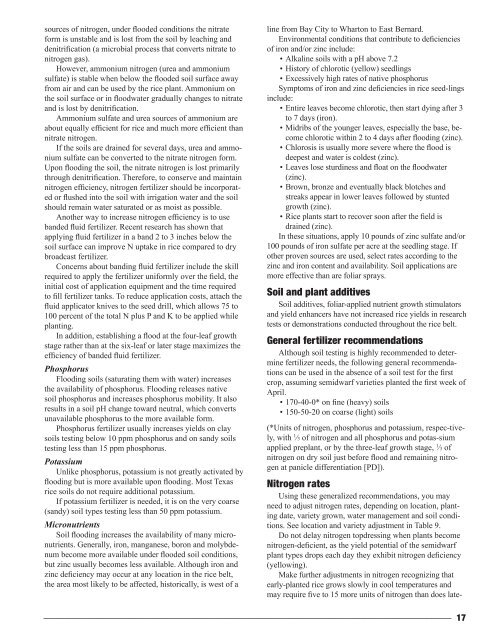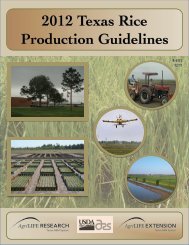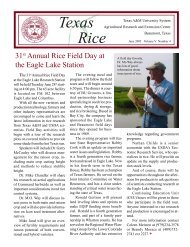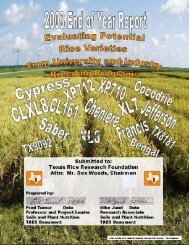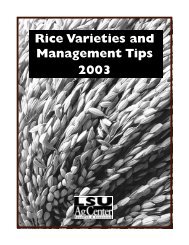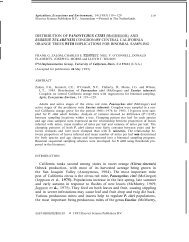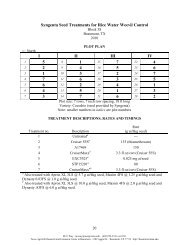2007 - Texas A&M AgriLIFE Research Center at Beaumont - Texas ...
2007 - Texas A&M AgriLIFE Research Center at Beaumont - Texas ...
2007 - Texas A&M AgriLIFE Research Center at Beaumont - Texas ...
You also want an ePaper? Increase the reach of your titles
YUMPU automatically turns print PDFs into web optimized ePapers that Google loves.
sources of nitrogen, under flooded conditions the nitr<strong>at</strong>e<br />
form is unstable and is lost from the soil by leaching and<br />
denitrific<strong>at</strong>ion (a microbial process th<strong>at</strong> converts nitr<strong>at</strong>e to<br />
nitrogen gas).<br />
However, ammonium nitrogen (urea and ammonium<br />
sulf<strong>at</strong>e) is stable when below the flooded soil surface away<br />
from air and can be used by the rice plant. Ammonium on<br />
the soil surface or in floodw<strong>at</strong>er gradually changes to nitr<strong>at</strong>e<br />
and is lost by denitrific<strong>at</strong>ion.<br />
Ammonium sulf<strong>at</strong>e and urea sources of ammonium are<br />
about equally efficient for rice and much more efficient than<br />
nitr<strong>at</strong>e nitrogen.<br />
If the soils are drained for several days, urea and ammonium<br />
sulf<strong>at</strong>e can be converted to the nitr<strong>at</strong>e nitrogen form.<br />
Upon flooding the soil, the nitr<strong>at</strong>e nitrogen is lost primarily<br />
through denitrific<strong>at</strong>ion. Therefore, to conserve and maintain<br />
nitrogen efficiency, nitrogen fertilizer should be incorpor<strong>at</strong>ed<br />
or flushed into the soil with irrig<strong>at</strong>ion w<strong>at</strong>er and the soil<br />
should remain w<strong>at</strong>er s<strong>at</strong>ur<strong>at</strong>ed or as moist as possible.<br />
Another way to increase nitrogen efficiency is to use<br />
banded fluid fertilizer. Recent research has shown th<strong>at</strong><br />
applying fluid fertilizer in a band 2 to 3 inches below the<br />
soil surface can improve N uptake in rice compared to dry<br />
broadcast fertilizer.<br />
Concerns about banding fluid fertilizer include the skill<br />
required to apply the fertilizer uniformly over the field, the<br />
initial cost of applic<strong>at</strong>ion equipment and the time required<br />
to fill fertilizer tanks. To reduce applic<strong>at</strong>ion costs, <strong>at</strong>tach the<br />
fluid applic<strong>at</strong>or knives to the seed drill, which allows 75 to<br />
100 percent of the total N plus P and K to be applied while<br />
planting.<br />
In addition, establishing a flood <strong>at</strong> the four-leaf growth<br />
stage r<strong>at</strong>her than <strong>at</strong> the six-leaf or l<strong>at</strong>er stage maximizes the<br />
efficiency of banded fluid fertilizer.<br />
Phosphorus<br />
Flooding soils (s<strong>at</strong>ur<strong>at</strong>ing them with w<strong>at</strong>er) increases<br />
the availability of phosphorus. Flooding releases n<strong>at</strong>ive<br />
soil phosphorus and increases phosphorus mobility. It also<br />
results in a soil pH change toward neutral, which converts<br />
unavailable phosphorus to the more available form.<br />
Phosphorus fertilizer usually increases yields on clay<br />
soils testing below 10 ppm phosphorus and on sandy soils<br />
testing less than 15 ppm phosphorus.<br />
Potassium<br />
Unlike phosphorus, potassium is not gre<strong>at</strong>ly activ<strong>at</strong>ed by<br />
flooding but is more available upon flooding. Most <strong>Texas</strong><br />
rice soils do not require additional potassium.<br />
If potassium fertilizer is needed, it is on the very coarse<br />
(sandy) soil types testing less than 50 ppm potassium.<br />
Micronutrients<br />
Soil flooding increases the availability of many micronutrients.<br />
Generally, iron, manganese, boron and molybdenum<br />
become more available under flooded soil conditions,<br />
but zinc usually becomes less available. Although iron and<br />
zinc deficiency may occur <strong>at</strong> any loc<strong>at</strong>ion in the rice belt,<br />
the area most likely to be affected, historically, is west of a<br />
line from Bay City to Wharton to East Bernard.<br />
Environmental conditions th<strong>at</strong> contribute to deficiencies<br />
of iron and/or zinc include:<br />
• Alkaline soils with a pH above 7.2<br />
• History of chlorotic (yellow) seedlings<br />
• Excessively high r<strong>at</strong>es of n<strong>at</strong>ive phosphorus<br />
Symptoms of iron and zinc deficiencies in rice seed-lings<br />
include:<br />
• Entire leaves become chlorotic, then start dying after 3<br />
to 7 days (iron).<br />
• Midribs of the younger leaves, especially the base, become<br />
chlorotic within 2 to 4 days after flooding (zinc).<br />
• Chlorosis is usually more severe where the flood is<br />
deepest and w<strong>at</strong>er is coldest (zinc).<br />
• Leaves lose sturdiness and flo<strong>at</strong> on the floodw<strong>at</strong>er<br />
(zinc).<br />
• Brown, bronze and eventually black blotches and<br />
streaks appear in lower leaves followed by stunted<br />
growth (zinc).<br />
• Rice plants start to recover soon after the field is<br />
drained (zinc).<br />
In these situ<strong>at</strong>ions, apply 10 pounds of zinc sulf<strong>at</strong>e and/or<br />
100 pounds of iron sulf<strong>at</strong>e per acre <strong>at</strong> the seedling stage. If<br />
other proven sources are used, select r<strong>at</strong>es according to the<br />
zinc and iron content and availability. Soil applic<strong>at</strong>ions are<br />
more effective than are foliar sprays.<br />
Soil and plant additives<br />
Soil additives, foliar-applied nutrient growth stimul<strong>at</strong>ors<br />
and yield enhancers have not increased rice yields in research<br />
tests or demonstr<strong>at</strong>ions conducted throughout the rice belt.<br />
General fertilizer recommend<strong>at</strong>ions<br />
Although soil testing is highly recommended to determine<br />
fertilizer needs, the following general recommend<strong>at</strong>ions<br />
can be used in the absence of a soil test for the first<br />
crop, assuming semidwarf varieties planted the first week of<br />
April.<br />
• 170-40-0* on fine (heavy) soils<br />
• 150-50-20 on coarse (light) soils<br />
(*Units of nitrogen, phosphorus and potassium, respec-tively,<br />
with 1 ⁄3 of nitrogen and all phosphorus and potas-sium<br />
applied preplant, or by the three-leaf growth stage, 1 ⁄3 of<br />
nitrogen on dry soil just before flood and remaining nitrogen<br />
<strong>at</strong> panicle differenti<strong>at</strong>ion [PD]).<br />
Nitrogen r<strong>at</strong>es<br />
Using these generalized recommend<strong>at</strong>ions, you may<br />
need to adjust nitrogen r<strong>at</strong>es, depending on loc<strong>at</strong>ion, planting<br />
d<strong>at</strong>e, variety grown, w<strong>at</strong>er management and soil conditions.<br />
See loc<strong>at</strong>ion and variety adjustment in Table 9.<br />
Do not delay nitrogen topdressing when plants become<br />
nitrogen-deficient, as the yield potential of the semidwarf<br />
plant types drops each day they exhibit nitrogen deficiency<br />
(yellowing).<br />
Make further adjustments in nitrogen recognizing th<strong>at</strong><br />
early-planted rice grows slowly in cool temper<strong>at</strong>ures and<br />
may require five to 15 more units of nitrogen than does l<strong>at</strong>e-<br />
–––––––––––––––––––––––––––––––––––––––––––––––––––––––––––––––––––––––––––––––––––– 17


